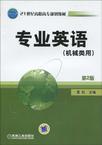专业英语
出版时间:2010-1 出版社:机械工业出版社 作者:夏虹 编 页数:180
前言
本教材是根据高中毕业3年制、兼顾2年制的高职高专教学计划需要编写而成的。 在编写本书时,我们从高职教育的实际出发,结合专业英语的教学实践,确定编写的指导思想和教材特色为:从机械专业出发,循着机械制造过程的自然顺序,由浅入深,由简到繁,循序渐进。 本书分为五大部分,共计45篇文章。所涉及的内容包括:工程材料、热处理、机械零件、机械加工及各类机床、切削原理、公差与配合、计算机辅助设计与制造、数控技术、机器人技术等。本书推荐学时为36学时,带s号内容可根据具体情况选用。 本书取材基本源于英、美、澳大利亚文献原著。为保持原著的语言风格,编者对原文只做删节,不做改写。在每篇短文后,给出了文中生词、词组以及某些专业词组,并对正文中一些疑难句子给出了注释或参考译文。短文后还给出部分思考题,供练习用。本书选材广泛,语言规范,难度适中,便于自学。 全书由夏虹主编。第一部分由夏虹和孙振忠编写,第二部分由许英姿编写,第三部分由杨爱兰编写,第四部分由王延遐编写,第五部分由夏虹编写,最后由夏虹、许英姿、孙振忠定稿。本书在编写过程中得到河南科技大学徐顺利副教授的大力帮助和悉心审阅,并担任了本书的主审。此外,还得到其他多方面人员的热心支持,对此,我们表示由衷的感谢! 由于水平有限,时间仓促,不足和错漏之处在所难免,祈望读者不吝赐教。
内容概要
本书是根据高等职业技术教育教学的要求编写的。全书共分4大部分,内容包括:机械工程材料、机械零件、机械加工和各类机床以及现代加工制造技术,同时附加了产品说明书范例和参考译文等内容,以便于教学、自学和应用。本书取材力求应用面广,并具有专业词汇量和语言丰富、实用性强的特点,希望读者借助本书的学习,能达到提高阅读水平和应用专业英语的目的。 本书可作为高等职业技术院校、高等院校专科、成人教育学院、职工大学等大专层次的机械类专业英语课程的教材,也可作为广大自学者和工程技术人员的参考用书。
书籍目录
第2版前言第1版前言 Part 1 Fundamentals of Manufacturing Unit 1 Definition of Manufacturing Unit 2 Design Materials and Production Unit 3 Engineering Materials Unit 4 Classification of Materials Unit 5 Properties of Materials Unit 6 Heat Treatment and Hot Working of Metals Unit 7 Mechanics Unit 8 Measurement Unit 9 Inspection and Quality Control Part 2 Mechanical Parts Unit 10 Link and Joint Unit 11 Power Screws Unit 12 Clutches Unit 13 Engine Parts Unit 14 Gears Unit 15 Gear Manufacture Unit 16 Shafts Unit 17 Springs Unit 18 Bett Drives Unit 19 Bearings Unit 20 Cams Unit 21 Turbine Engine Bearings for Ultra-High Temperatures Unit 22 CouplingsPart 3 Manufacturing Unit 23 Shaping and Planning Operations Unit 24 Grinding Machines Unit 25 Casting Unit 26 Die Casting and Investment (or Lost Wax) Casting Unit 27 Metal Cutting Unit 28 Fundamentals of Manufacturing Accuracy Unit 29 Surface RoughnessPart 4 New Technologies in Manufacturing Unit 30 Numerical Control (NC) Unit 31 CAD / CAM Unit 32 Scope of CAD/CAM Unit 33 Computer-Integrated Manufacturing Unit 34 Robots Unit 35 Machining Center Unit 36 List of Various Mcchatronic Systems Unit 37 Mechanical Engineering in the Information Age产品说明书范例参考译文词汇表参考文献
章节摘录
Ductility is a property that enables a material to be bent, drawn, stretched, formed, or permanently distorted without rupture. A material that has high ductility will not be brittle or very hard. Hard materials, on the other hand, are usually brittle and lack ductility. Impact and Endurance Testing A metal may be very hard and have a high tensile strength yet be totally unacceptable for a use that requires it to withstand impact or sudden load. There are a number of tests that can be used to determine the impact capability of a metal, but the test most generally used is the Chary test, Figure 1-3 shows a notched specimen that is struck by an anvil. The energy in foot-pounds requited to break the specimen is an indication of the impact resistance of the metal. The yield strength of metals can be used in designing parts that will withstand a static load, but for cyclic or repetitive loading the endurance or fatigue strength is useful. An endurance test is made by loading the part and subjecting it to repetitive stress. Figure 1-3 shows one way that the endurance or fatigue strength of a material may be found. Generally, a number of specimens of a metal are tested at various loading and the numbers of cycles to failure are noted. A curve of stress in pounds per square inch versus the number of cycles to failure is plotted, and these data can be used for designs involving repetitive loading. Hardness Although there are several techniques for determining the hardness of a material, most industrial methods measure the resistance to penetration of a small sphere, cone, or pyramid. Figure 1-3 shows a penetration hardness tester. The first step in obtaining a reading is to force the penetrator and material into contact with the specimen with a predetermined initial load. Then an increased load is applied to the penetrator, and the hardness reading is obtained by noting the difference in penetration caused by the final load as compared to the initial load.
图书封面
评论、评分、阅读与下载
用户评论 (总计1条)
- 两本书一起看很有效果的
